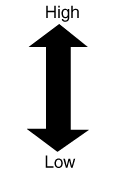| Adoption Of
Integrated Position Sensor With Tcu |
The shift position
sensor is integrated in TCU. TCU indicates a shift position by reading a
voltage difference between output voltages (Pos1,Pos2) from the shift
position sensor.

Function
Of TCU
| 1. |
Automatic gear shift control
In automatic gear shift control, based on
each gear shift pattern, S1 and S2 turn on or off and SLC1, SLC2,
SLC3, and SLB1 are operated linearly according to information that
includes vehicle speed, Throttle valve opening degree, and brake
signals. |
| 2. |
Lock-up control
Based on rpm signals, signals from the
engine control unit (engine rpm and throttle opening) and vehicle
speed, smooth lock-up control is achieved through linear control of
the lock-up control solenoid (SLU). (However, this assumes that
JWS-3309 is used.) |
| 3. |
Garage shift control
When the shift lever is moved from N to D or
from N to R, after the engine is started, a shift control solenoid
(SLC1,SLC3) is used for the oil pressure required by C1 clutch or C3
clutch and appropriately regulated oil pressure is supplied to the
clutch, engaging smoothly without shock.
| • |
When the engine is cold, the
first piston stroke resistance increases, creating a
time lag in shift operation. In order to reduce the time
lag, control is not
performed. |
| • |
By controlling the oil pressure
according to the piston stroke, smooth engagement
without shock becomes
possible. | | |
| 4. |
Reverse control
If the shift lever is moved from N to R
while the vehicle is traveling and the transmission shifts into
reverse, the wheels may be locked, which is extremely dangerous. In
order to avoid this, TCU inhibits the transmission from shifting
into reverse while traveling.
| • |
Even when the shift lever is
moved from N to R, the transmission does not shift into
reverse if the vehicle speed is 11 km/h or
more. |
| • |
When this control is activated,
the C3 clutch is released without operating the shift
control solenoid (SLC3) so that the transmission does
not shift into reverse. |
| • |
Reverse control takes precedence
over N-R shift
control. | | |
| 5. |
Self-diagnosis function
The TCU monitors the communication status of
each sensor, electronic component and ECU including the engine
control unit. If any malfunction should occur, the TCU functions to
warn the driver and stores the malfunction as a diagnosis
code. |
| 6. |
Fail-safe
With the fail-safe function, if any
malfunction should occur in the automatic transmission system, the
TCU will output a control signal, and control will be performed to
make traveling a minimum distance possible. If shift solenoid
malfunction, the TCU will cancel the output of control signals to
the solenoid. If this happens, automatic transmission gear shifting
will be controlled by oil pressure circuits only and the gears will
shift as shown in the chart below.
Shift
position
|
Gear
position
|
R
|
Reverse
|
D
|
3rd gear (5th gear in case of SLC1
failure)
|
|
| 7. |
Driver adaptive shift control
The F21 for HMC does not have a driving mode
selection switch that allows drivers to select a mode themselves.
The vehicle is ordinarily in economy mode. However, when specific
conditions are met, the TCU selects a shifting pattern appropriate
to driving conditions from all of the shifting patterns and switches
automatically. |
Mode
|
Description
|
ECONOMY
|
Used during normal driving. ECONOMY mode is basic shift
schedule and the ideal shift schedule to be consistent with fuel
economy and acceleration performance. This mode is normally selected
where no other higher priority shift mode is activated. Full shift
schedule map is available including lockup for this
mode.
|
HIGH OIL TEMPERATURE (HOT)
|
This mode is protect the gearbox from the overheating.
This mode is activated where the T/M oil temperature is too high,
and will prevent the T/M oil temperature increasing by torque
converter slipping. HOT shift schedule maps is available including
lockup depending on the T/M oil temperature area for this
mode.
|
MANUAL SHIFT MODE
|
The manual shift mode is activated where the driver put
the shifter into manual gate. The gear position is manually changed
according to the driver shift demand. The automatic down shift
function in decelerating and automatic up shift function for engine
over revolution protection are available. The allowable vehicle
speed for up shifting at low vehicle speed and down shifting at high
speed set be TCU parameters.
|
UP-SLOPE (US1,2)
|
The UP-SLOPE1,2 mode detect up hill road condition and
change the shift map to powerful map to avoid busy shifting at up
hill condition. When start condition of up slope mode is detected,
shift map is changed upslope1 or upslope2 map depending on slope
gradient if no higher priority mode is activated.
|
AUTO CRUISE CONTROL (ACC)
|
The AUTO CRUSE CONTROL detects "ACC ON" signal and use
specific point to prevent shift hunting during ACC ON. When cruise
control is ON, gears are fixed to perform smooth
driving.
|
GEAR HOLD
|
The GEAR HOLD according to the request by ESP in order
to support the vehicle stability. This function can be activated in
every shift mode except for MANUAL SHIFT MODE. When start condition
is fulfilled, gear is held to current gear. The gear hold is
performed after shift control finished if start condition is
fulfilled during shifting.
|
Mode Priority On Current
Implementation
Mode priority
|
Shift mode
|
|

|
MANUAL SHIFT MODE
|
GEAR HOLD
|
HOT
|
UP-SLOPE 2
|
UP-SLOPE 1
|
AUTO CRUISE CONTROL
|
ECONOMY
| |